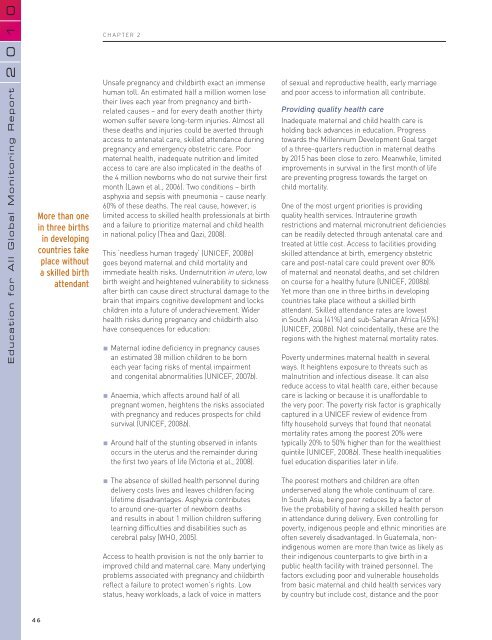Chapter 2. Progress towards the EFA goals - Unesco
Chapter 2. Progress towards the EFA goals - Unesco
Chapter 2. Progress towards the EFA goals - Unesco
Create successful ePaper yourself
Turn your PDF publications into a flip-book with our unique Google optimized e-Paper software.
0<br />
1<br />
0<br />
CHAPTER 2<br />
2<br />
Education for All Global Monitoring Report<br />
More than one<br />
in three births<br />
in developing<br />
countries take<br />
place without<br />
a skilled birth<br />
attendant<br />
Unsafe pregnancy and childbirth exact an immense<br />
human toll. An estimated half a million women lose<br />
<strong>the</strong>ir lives each year from pregnancy and birthrelated<br />
causes – and for every death ano<strong>the</strong>r thirty<br />
women suffer severe long-term injuries. Almost all<br />
<strong>the</strong>se deaths and injuries could be averted through<br />
access to antenatal care, skilled attendance during<br />
pregnancy and emergency obstetric care. Poor<br />
maternal health, inadequate nutrition and limited<br />
access to care are also implicated in <strong>the</strong> deaths of<br />
<strong>the</strong> 4 million newborns who do not survive <strong>the</strong>ir first<br />
month (Lawn et al., 2006). Two conditions – birth<br />
asphyxia and sepsis with pneumonia – cause nearly<br />
60% of <strong>the</strong>se deaths. The real cause, however, is<br />
limited access to skilled health professionals at birth<br />
and a failure to prioritize maternal and child health<br />
in national policy (Thea and Qazi, 2008).<br />
This ‘needless human tragedy’ (UNICEF, 2008b)<br />
goes beyond maternal and child mortality and<br />
immediate health risks. Undernutrition in utero, low<br />
birth weight and heightened vulnerability to sickness<br />
after birth can cause direct structural damage to <strong>the</strong><br />
brain that impairs cognitive development and locks<br />
children into a future of underachievement. Wider<br />
health risks during pregnancy and childbirth also<br />
have consequences for education:<br />
Maternal iodine deficiency in pregnancy causes<br />
an estimated 38 million children to be born<br />
each year facing risks of mental impairment<br />
and congenital abnormalities (UNICEF, 2007b).<br />
Anaemia, which affects around half of all<br />
pregnant women, heightens <strong>the</strong> risks associated<br />
with pregnancy and reduces prospects for child<br />
survival (UNICEF, 2008b).<br />
Around half of <strong>the</strong> stunting observed in infants<br />
occurs in <strong>the</strong> uterus and <strong>the</strong> remainder during<br />
<strong>the</strong> first two years of life (Victoria et al., 2008).<br />
of sexual and reproductive health, early marriage<br />
and poor access to information all contribute.<br />
Providing quality health care<br />
Inadequate maternal and child health care is<br />
holding back advances in education. <strong>Progress</strong><br />
<strong>towards</strong> <strong>the</strong> Millennium Development Goal target<br />
of a three-quarters reduction in maternal deaths<br />
by 2015 has been close to zero. Meanwhile, limited<br />
improvements in survival in <strong>the</strong> first month of life<br />
are preventing progress <strong>towards</strong> <strong>the</strong> target on<br />
child mortality.<br />
One of <strong>the</strong> most urgent priorities is providing<br />
quality health services. Intrauterine growth<br />
restrictions and maternal micronutrient deficiencies<br />
can be readily detected through antenatal care and<br />
treated at little cost. Access to facilities providing<br />
skilled attendance at birth, emergency obstetric<br />
care and post-natal care could prevent over 80%<br />
of maternal and neonatal deaths, and set children<br />
on course for a healthy future (UNICEF, 2008b).<br />
Yet more than one in three births in developing<br />
countries take place without a skilled birth<br />
attendant. Skilled attendance rates are lowest<br />
in South Asia (41%) and sub-Saharan Africa (45%)<br />
(UNICEF, 2008b). Not coincidentally, <strong>the</strong>se are <strong>the</strong><br />
regions with <strong>the</strong> highest maternal mortality rates.<br />
Poverty undermines maternal health in several<br />
ways. It heightens exposure to threats such as<br />
malnutrition and infectious disease. It can also<br />
reduce access to vital health care, ei<strong>the</strong>r because<br />
care is lacking or because it is unaffordable to<br />
<strong>the</strong> very poor. The poverty risk factor is graphically<br />
captured in a UNICEF review of evidence from<br />
fifty household surveys that found that neonatal<br />
mortality rates among <strong>the</strong> poorest 20% were<br />
typically 20% to 50% higher than for <strong>the</strong> wealthiest<br />
quintile (UNICEF, 2008b). These health inequalities<br />
fuel education disparities later in life.<br />
The absence of skilled health personnel during<br />
delivery costs lives and leaves children facing<br />
lifetime disadvantages. Asphyxia contributes<br />
to around one-quarter of newborn deaths<br />
and results in about 1 million children suffering<br />
learning difficulties and disabilities such as<br />
cerebral palsy (WHO, 2005).<br />
Access to health provision is not <strong>the</strong> only barrier to<br />
improved child and maternal care. Many underlying<br />
problems associated with pregnancy and childbirth<br />
reflect a failure to protect women’s rights. Low<br />
status, heavy workloads, a lack of voice in matters<br />
The poorest mo<strong>the</strong>rs and children are often<br />
underserved along <strong>the</strong> whole continuum of care.<br />
In South Asia, being poor reduces by a factor of<br />
five <strong>the</strong> probability of having a skilled health person<br />
in attendance during delivery. Even controlling for<br />
poverty, indigenous people and ethnic minorities are<br />
often severely disadvantaged. In Guatemala, nonindigenous<br />
women are more than twice as likely as<br />
<strong>the</strong>ir indigenous counterparts to give birth in a<br />
public health facility with trained personnel. The<br />
factors excluding poor and vulnerable households<br />
from basic maternal and child health services vary<br />
by country but include cost, distance and <strong>the</strong> poor<br />
46
















